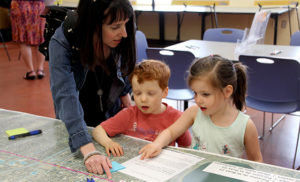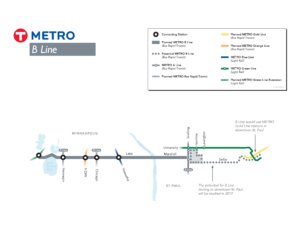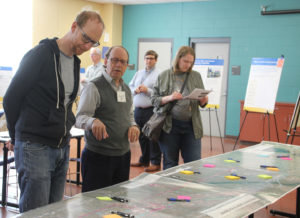 Christina Morrison with four-year-old twins Jack and Keira, learn about the proposed B Line along Lake/Marshall. (Photo by Tesha M. Christensen)
Christina Morrison with four-year-old twins Jack and Keira, learn about the proposed B Line along Lake/Marshall. (Photo by Tesha M. Christensen)By TESHA M. CHRISTENSEN
tesha@monitorsaintpaul.com
Travel down Marshall Ave./Lake St. by bus is slow with stops on the Route 21 every two blocks.
During rush hour, buses slow to average speeds of only eight miles per hour, and it’s considered one of the slowest transit corridors in the metro.
Red lights mean that buses are moving less than half the time.
And over 10,000 rides are taken on this route per day.
For those people, things are about to get faster.
Metro Transit plans to construct the region’s third bus rapid transit line on Lake St./Marshall Ave. in 2022.
With things in the planning stage now for the B Line, a series of open houses was held in May, including one at South High School on Wednesday, May 1, 2019 and another at the Oxford Community Center on Saturday, May 4.
“There’s a lot of congestion and a lot of delay,” observed Metro Transit Senior Planner Adam Smith.
“Anything that could improve our transit service is something I’m interested in,” stated Brian Kimnes who lives in the Hamline-Midway neighborhood of St. Paul and works off Lake St. in the Longfellow neighborhood of Minneapolis. If the bus line was faster, it would make it much more likely that he’d take the bus to work instead of his car, he said.
If he goes to the Lyn-Lake area now, he drives because the bus is “excruciatingly slow,” he stated. “It stops every block and it’s a painful experience. I can drive there in 20 minutes or take the bus for 50.”
HOW IS IT FASTER?
The B Line would make the trip about 20% faster. The savings would come by stopping less often, allowing customers to board faster, and stopping at fewer red lights.
With bus rapid transit, buses make limited stops at stations spaced farther apart, such as every 1/3 to 1/2 mile between stations instead of very other block.
Fares are collected at stations, just like light rail, instead of on the bus. B line buses run in general traffic and stations are built on curb bump-outs to avoid delays caused by merging back into traffic.
BRT lines also use transit signal priority, where buses “ask” traffic signals for early or extended green lights.
There are several options Metro Transit is looking at and gathering input on, such as queue jumps and a dedicated lane for buses, according to project manager Cody Olson. The dedicated lane would be more challenging along Lake St. but easier to do on Marshall, he observed. It could be ‘Buses Only’ during certain times of the day and multi-use at other times.
Bus approach lanes at intersections could speed things up for buses, as well.
 SOME FOR, SOME AGAINST
SOME FOR, SOME AGAINST
Elizabeth Ellis lives at Fairview and Taylor. She said that she is “vehemently opposed” to the B Line. When she’s on a bus route along the A Line, she is dismayed to see BRT buses pass her by rather than pick her up as regular buses do. “This designated only thing in the winter is awful,” Ellis said.
"I love the bus. Need the bus. Depend on the bus,” Ellis remarked.
Highland Park resident Christina Morrison and her two four-year-old children, Jack and Keira, are looking forward to the B Line and regularly ride the A Line. Morrison is a Metro Transit employee. “We ride the bus everywhere,” she said. “I like the freedom. You can go wherever you need to go.”
She appreciates that she doesn’t need to lug around car seats for the kids when they ride the bus. “Kids ride for free so that’s a big incentive for us to ride as a family,” Morrison added. “They can wiggle and look out the window.”
She believes that this area of St. Paul will benefit from the more frequent service offered by the B Line.
WILL IT REPLACE ROUTE 21?
The B line could potentially fully replace the Route 21 bus and offer high frequency service all day and on nights and weekends.
Some of the biggest questions, in addition to where to locate stations, are what route the line should take in St. Paul. There are several options planners are looking at, including using University or Selby and going all the way to downtown St. Paul.
At the open houses, attendees were asked to rate which the following in terms of priority: overall travel time, bus arriving at planned time, bus arrives as steady frequency, smooth ride - less starting and stopping, less delay in traffic or stoplights, walking distance to bus stop, and amenities at stop.
Send comments to bline@metrotransit.org.
 Residents and Metro Transit staff chat during an open house on May 4, 2019 at the Oxford Community Center, giving input on things such as overall travel time, bus frequency, bus stop amenities, and more. Send comments to bline@metrotransit.com. (Photo by Tesha M. Christensen)
Residents and Metro Transit staff chat during an open house on May 4, 2019 at the Oxford Community Center, giving input on things such as overall travel time, bus frequency, bus stop amenities, and more. Send comments to bline@metrotransit.com. (Photo by Tesha M. Christensen)DID YOU KNOW?
>> The B Line is planned to be the fourth of several planned BRT lines that will bring faster, frequent service to the region’s busiest transit corridors.
>> The region’s first arterial BRT line, the A Line, opened in 2016 and has boosted corridor ridership by about one third.
>> Construction on the C Line, serving Minneapolis and Brooklyn Center, is underway. Service is scheduled to begin in 2019.
>> The D Line, serving the Route 5 corridor from Bloomington to Brooklyn Center, is currently in design, targeted for construction to begin in 2020.
>>The E Line, serving the Route 6 corridor on Hennepin Avenue is in the corridor study phase through 2019, with construction targeted for 2023.
>> The West Lake Street Station will be the western terminus of the B Line and will be built in coordination with the Southwest LRT project. The B Line station will be built on the West Lake Street bridge and will have access to the LRT station via stairs and elevator.
>> The I35W and Lake Street Station will provide a connection to the METRO Orange Line and the broader 35W@94:Downtown to Crosstown project includes a redesign of the freeway between I-94 and 42nd Street.
>> An eastbound enhanced bus stop at Lake and Hiawatha was built in conjunction with the construction of the South Minneapolis Regional Service Center in 2017, and will be used by the future B Line. The westbound station location will be implemented in coordination with this project.
>> A completed BRT network would cover 100 miles and include 400 enhanced stations, directly serving about 20 percent of the region’s residents and more than 230,000 jobs.
>>BRT lines have the potential to see an estimated 160,000 average weekday boardings by 2030, representing about a third of total bus ridership.
Learn more at metrotransit.org/abrt.
~ Information from Metro Transit
Will Route 21 Remain?
Metro Transit is weighing the pros and cons of keeping the underlying Route 21 when the B Line opens.
When the A Line opened in 2016, Metro Transit continued to operate Route 64 in the same corridor as a less frequent local travel option. A similar approach was taken Route 16, which provides local service alongside the Green Line Lightrail along University Ave. With the B Line and E Line (Hennepin Avenue corridor), Metro Transit is considering fully replacing the underlying local bus service.
Why? Well, as the A Line and the Green Line have been successful in attracting riders, the local service on Routes 84 and 16 have declined, leading to service reductions.
About Route 21
>> More than 10,000 average weekday rides, second-highest Metro transit route
>> Third most productive local bus route in terms of number of passengers per hour of service
>> One of the routes on which customers most frequently experience crowded buses
>> Carries up to 20% of people in vehicles in some palces while making up less than 2% of vehicles
>> Highest ridership between Hennepin Ave. and Hiawatha Ave.
>> Weekend and midday ridership also make up an important part of Route 21 ridership
>> Ridership has been declining.
~ Information from Metro Transit
Comments
No comments on this item Please log in to comment by clicking here